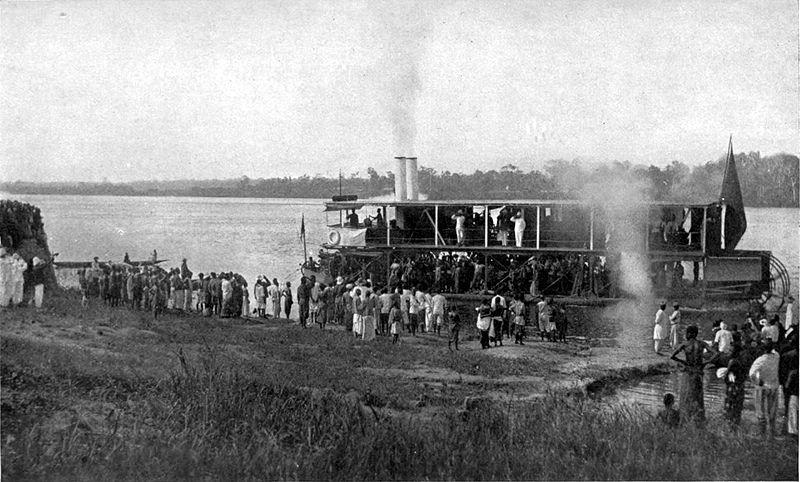 |
| Flag of Congo Free State |
In 1870 the Congo basin was unknown to Europeans. It contained 250 ethnic groups, 15 cultural regions mostly speaking Bantu languages, and a diverse climate and terrain, chiefly savanna and dense rain forest.
States were highly organized, with some large kingdoms; agriculture was varied; technology was somewhat developed, particularly metalworking; cloth and artworks were elegant, especially wood carvings, later partly inspiring cubism. Economies flourished despite unhealthy lowlands and depredations of East African slaves.
In 1877 Henry Morton Stanley completed tracing the 3,000-mile Congo River, emerging at its Atlantic mouth. British disinterest led Stanley to approach Leopold II of Belgium, whose machinations along with Stanley’s creations of stations on the Congo resulted, after the 1884– 85 Congress of Berlin, in the establishment of the Congo Free State with Leopold as the sole owner.
  |
It had 22 miles of coastline, about 900,000 square miles of vaguely defined interior, and a blue flag with a gold star. Initially it exported palm products and ivory, until most of the elephants were killed.
It was governed from Brussels; administrators were European volunteers. Indigenes were used for porterage, railroad and road building, harvesting wild rubber, and lumbering. From 1891 on, coercion forced workers to turn all ivory and rubber over to the state.
 |
| Congo Free State in 1899 |
Forced labor requirements were high. They were stabilized at 40 hours per month in 1903, which in practice often meant more than 20 days. Much land was awarded to commercial concessions; the remainder mostly became the property of the Congo state and then to Leopold. As a result, indigenous economies were destroyed.
In the late 1890s the Congo became profitable, as world demand for rubber grew. Greed, both Leopold’s (chiefly to embellish Belgium) and that of commercial concessions, along with demands for wild rubber, quota systems, and forced labor caused abuses and depopulation as well as dwindling amounts of rubber owing to lack of conservation and brutal slashing of vines.
Pressure for profit led to serfdom, lashings, physical mutilations (cutting off of ears or hands), and murder, especially by commercial concessions. Resistance was widespread and often effective; villages fled at the sight of a white man.
   |
By 1900 criticism of the Congo’s maladministration mounted in both Britain and the United States. Leopold was indifferent to it. Many aspects of the situation in the Congo were not unique, but it and Leopold were easier targets than the Great Powers
The campaign of E. D. Morel
 |
| Leopold II of Belgium |